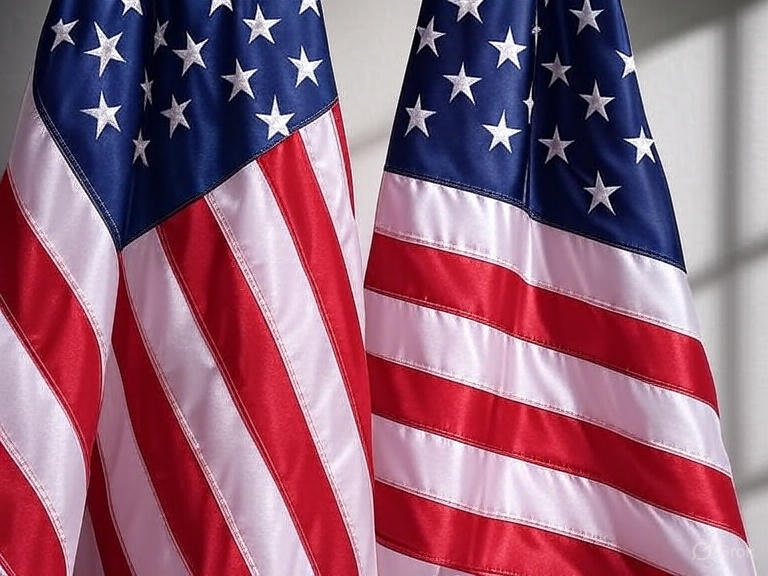Nylon vs. Polyester Flags: Differences, Choices, and Feel
When choosing a flag for your business, home, or event, the material matters. Nylon and polyester are the two most popular synthetic fabrics for flags, each offering distinct advantages depending on your needs. Drawing from expertise at Flags Unlimited, a leading American flag and flagpole company since 1985, this article explores the key differences between nylon and polyester flags, reasons to choose one over the other, and how they differ in feel.
Key Differences Between Nylon and Polyester Flags
Nylon and polyester flags are both durable and synthetic, but their properties cater to different environments and uses. Here are the primary differences, informed by Flags Unlimited’s insights:
-
Weight and Flyability: Nylon flags, made from 200-denier material, are lightweight and tightly woven, allowing them to flutter in the slightest breeze. This makes them ideal for most flag displays where consistent movement enhances visibility. Polyester flags, constructed from two-ply material with an open weave, are heavier, requiring stronger winds to fly effectively but offering superior durability in high-wind conditions.
-
Durability and Weather Resistance: Nylon is strong and dries quickly, making it suitable for areas with moderate weather or frequent rain. However, it may fray faster in extreme conditions. Polyester’s open weave allows wind to pass through, reducing stress on the fabric and extending its lifespan in high-wind areas like coastlines or highways. Flags Unlimited recommends polyester for such environments due to its exceptional wear resistance.
-
Appearance: Nylon flags have a rich, lustrous finish, giving them a vibrant and glossy look that enhances color brilliance. Polyester flags, while durable, have a duller, rougher surface that may not appear as shiny but maintains a professional, sturdy aesthetic.
Why Choose Nylon?
Nylon is the go-to choice for most flag displays, particularly in moderate climates or for indoor use. Here’s why you might choose nylon, per Flags Unlimited’s guidance:
-
Vibrant Display: The glossy finish and tight weave of nylon create a visually striking appearance, ideal for businesses aiming to capture attention with bright, fluttering flags.
-
Lightweight Movement: Nylon flags fly easily in light breezes, ensuring constant motion that draws the eye, which is crucial for boosting brand visibility in retail or event settings.
-
Quick-Drying: Nylon’s ability to dry quickly makes it perfect for areas with occasional rain, reducing downtime and maintaining a polished look.
-
Versatility: Flags Unlimited notes that nylon is suitable for wall-mounted flagpoles and most outdoor displays, offering flexibility for various setups.
Choose nylon if your flag will be displayed in a low-to-moderate wind area, indoors, or where vibrant aesthetics are a priority.
Why Choose Polyester?
Polyester is the preferred choice for demanding environments where durability is paramount. Flags Unlimited highlights these reasons to opt for polyester:
-
High-Wind Durability: The open-weave, two-ply polyester material is designed for high-wind conditions, making it ideal for coastal areas, highways, or industrial sites where flags face constant wind stress.
-
Longevity: Polyester flags wear exceptionally well, resisting fraying and tearing better than nylon, which means fewer replacements and long-term cost savings.
-
Professional Aesthetic: While less shiny, polyester’s coarser texture gives it a robust, traditional look that suits businesses seeking a sturdy, reliable image.
Choose polyester if your flag will be flown 24/7 in harsh weather, high-wind areas, or where long-term durability outweighs the need for vibrant flyability.
Feel Comparison: Nylon vs. Polyester
The tactile experience of a flag can influence its perceived quality and suitability for specific displays. Here’s how nylon and polyester differ in feel, based on Flags Unlimited’s descriptions and industry insights:
-
Nylon Feel: Nylon flags are smooth and silky to the touch, with a lightweight, flexible texture. This softness, combined with its lustrous sheen, gives nylon a premium, elegant feel that’s often associated with high-quality displays. It’s ideal for indoor settings or ceremonial uses where a refined texture enhances the flag’s appeal.
-
Polyester Feel: Polyester flags have a coarser, rougher texture, resembling traditional cotton but with a heavier, more substantial feel. The two-ply construction adds to its weight and sturdiness, making it feel more robust and durable. This texture suits outdoor displays where a rugged, dependable appearance is desired.
Practical Considerations
Flags Unlimited emphasizes matching the material to your display environment. For multi-flag displays, they recommend using the same material for consistency in appearance and performance. Here are additional tips:
-
Location: Use nylon for wall-mounted or indoor displays and polyester for high-wind outdoor settings like shorelines.
-
Maintenance: Both materials are machine-washable with mild detergent, but nylon dries faster, while polyester’s durability requires less frequent cleaning.
-
Budget: Nylon is generally more affordable, but polyester’s longevity may offer better value in harsh conditions.
Conclusion
Choosing between nylon and polyester flags depends on your display goals, environment, and aesthetic preferences. Nylon, with its vibrant colors, lightweight flyability, and smooth, silky feel, is perfect for most settings, especially where visual appeal and movement are key. Polyester, with its durable, open-weave construction and coarser, robust feel, excels in high-wind areas where longevity is critical. Flags Unlimited’s expertise in crafting both nylon and polyester flags ensures you can find a high-quality option tailored to your needs. Whether you prioritize brilliance or durability, the right flag material will elevate your display and leave a lasting impression.
*Written with the help of AI

